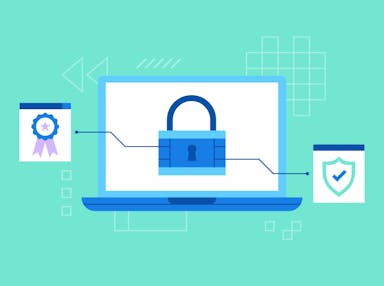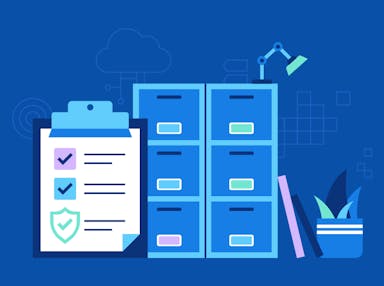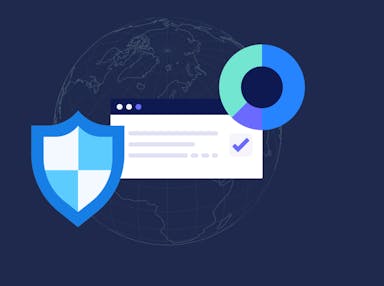
Cloud Compliance: Challenges + 11 Best Practices for Improving It
Anna Fitzgerald
Senior Content Marketing Manager
Rob Gutierrez
Senior Cybersecurity and Compliance Manager, CISA, CCSK, CMMC RP
In the past year, 80% of companies have experienced a cloud security breach.
And that number is only growing: a report by Jupiter One revealed a nearly 600% annual growth in vulnerable cloud attack surface, with a 589% increase in the number of unresolved security vulnerabilities.
To protect your company from costly cloud security vulnerabilities that could lead to breaches, it's essential that you understand and follow cloud compliance requirements.
Below we’ll take a closer look at what cloud compliance is. Then we’ll discuss the importance of cloud security compliance and provide tips to strengthen your cloud security.
What is cloud compliance?
Cloud compliance is the process of complying with cloud usage regulatory standards as well as local, national, and international laws.
In other words, to be cloud compliant, your organization’s cloud computing services must follow all requirements, including:
- Industry standards like the Payment Card Industry Data Security Standard (PCI DSS) and the Health Insurance Portability and Accountability Act (HIPAA) for healthcare organizations
- Laws like the EU’s General Data Protection Regulation (GDPR)
- Any internal governance policies that a company creates to achieve its goals and objectives
Let’s take a closer look at these components below.

Components of cloud compliance
Cloud compliance requirements will vary depending on your industry and the regulations that guide your business.
We dig into the components that shape general cloud compliance below.
Standards
Certain industries outline specific instructions for properly handling data within the cloud. These are known as cloud security compliance standards.
For example, ISO includes cloud-specific security controls within ISO 27017 and ISO 27018. That means implementing specific information security controls regarding the configuration of your cloud environment.
HIPAA also specifies that a covered entity and their cloud service provider (CSP) must enter into a business associate agreement where the CSP will be held liable for compliance with HIPAA Rules.
Laws and regulations
Laws and regulations — at the global, national, and state levels — also help shape cloud compliance requirements.
It’s important to understand your country’s laws and regulations for cloud compliance, data privacy, data protection and localization, and cybersecurity.
A few common regulations include HIPAA, PCI DSS, and SOX.
Governance
Cloud governance controls help manage a company’s data within the cloud and provide clear security policies on how to use (and how not to use) the cloud.
Companies should have guidelines on organizing, sharing, and tracking information on the cloud and expanding cloud usage. These should also cover ownership and responsibility of cloud strategy.
Why is cloud compliance important?
As of 2025, approximately 60% of all corporate data is stored in the cloud, and 48% of businesses store their most important data in the cloud.
With more sensitive data moving to the cloud, businesses must understand their own role and responsibility for keeping that data safe, including achieving and maintaining compliance with cloud requirements. This is essential for not only building customer trust, but also for avoiding costly data breaches.

According to research by IBM, 82% of all breaches involved data stored in the cloud—including the public cloud, private cloud, or multiple environments. The cost of these breaches were also typically higher than average. The average cost of breaches involving data stored across multiple environments was USD 4.75 million and the average cost of breaches involving data stored in the public cloud was USD 4.57 million, which was 6.7% and 2.7% higher respectively than the average cost of all data breaches in 2023.
In short, cloud compliance can help you reap the benefits of cloud computing — cost-effectiveness, backup and recovery of data, scalability — while maintaining a strong security posture.
Cloud compliance challenges
While cloud solutions offer a variety of benefits, they also come with a unique set of challenges.
Operational complexity due to multi-cloud environments
The 2023 Thales Global Cloud Security Study shows a growing number of companies are using more cloud service providers. More than three-quarters (79%) of this year’s respondents have more than one cloud provider, with the average number at 2.3.
This means that organizations are challenged with an increased attack surface and potential for operational errors when securing more platforms. They also must ensure their increasingly complex cloud environment is in compliance with all applicable requirements. To address these challenges, organizations may need to create separate teams for each platform they use, or upskill or expand their security team to be able to secure multiple platforms at the same time and achieve cloud compliance.
Shadow IT and data
Increased cloud usage also opens the door to shadow IT if employees use cloud technology without explicit approval. This term may sound scary, but in practice shadow IT could be as simple as purchasing additional cloud storage without proper approval. Left unchecked, shadow IT can lead to lost data, an increased attack surface, and non-compliance.
Fast-paced adoption of cloud apps and services is also compounding the risk of shadow data, which refers to sensitive data that is not being tracked or managed. Shadow data increases compliance risk, especially in multi-cloud environments.
Over-reliance on cloud service provider’s security
Using a well-known CSP can also give companies a false sense of data security and lead to compliance gaps.
Take the 2021 Azure Cosmos DB vulnerability, for example. Used by brands like Mercedes-Benz and Mars, Incorporated, the database experienced a large vulnerability that made it possible for a user to steal the access key of another. This vulnerability went undetected for two years.
This shows that Microsoft Azure, like other well-known CSPs, can experience vulnerabilities — even if they have a hefty list of compliance certifications. That’s why it’s so important for businesses using CSPs to put a high priority on their own security management and compliance monitoring.
11 tips for better cloud compliance
Wondering how you can level up your cloud compliance practices? We offer eight tips below.

1. Identify regulations and guidelines
The first step in achieving cloud compliance is identifying which regulations and industry standards your organization needs to comply with.
Common cloud compliance frameworks include:
Recommended reading

Essential Guide to Security Frameworks & 14 Examples
2. Understand responsibility
Many cloud providers like Amazon Web Services (AWS) outline specific cloud usage responsibilities. AWS uses the shared responsibility model, which splits responsibility between AWS and the customer.
AWS is responsible for security of the infrastructure that runs all of the services in the AWS Cloud. The customer is responsible for the secure configurations of the cloud services in use as well as any customer data. The latter may follow the AWS Foundational Technical Review (FTR), a framework that includes some of their best practices and requirements for reducing risks around security, reliability, and operational excellence.
The AWS shared responsibility model leads many businesses to mistakenly think that all compliance responsibility falls on AWS. This is not the case.
The burden of compliance ultimately falls on the business’s shoulders because you are responsible for the data you choose to put on the cloud and the secure configuration of the services in use.
3. Understand the unique requirements of your cloud environment
In addition to the shared security responsibility, a cloud environment’s service and deployment model affects who handles security requirements. The most common services are Infrastructure as a Service (IaaS), Platform as a Service (PaaS), and Software as a Service (SaaS). The most common deployment models are public, private, and hybrid.
For example, in a PaaS environment, the administrator is responsible for the applications while the CSP is responsible for the physical servers, physical network, hypervisor, and operating systems. Who handles the inventory and control of hardware assets would differ for hybrid and public cloud environments.
To ensure you’re following security and compliance best practices, you must understand the unique risks and requirements of your cloud environment.
4. Ensure proper access control
Just like companies have a process for sharing access control with new hires or vendors, you need something similar when it comes to cloud security.
Companies should establish a policy for limiting and granting access to their cloud environment, networks, instances, and data stored within it. You can also introduce need-based access rules and expiration dates to help you keep track of who has access and for how long. Ensuring who has access to your network and how traffic flows within the network is critical to proper access control and ensuring that least privilege and least functionality has been implemented.
5. Classify your data.
When it comes to storing data on the cloud, it’s important to know where server locations are because many regulations require servers to reside within the U.S.
Once you’ve chosen a cloud provider, you need to determine what types of data you want to live on the cloud. You can do this by classifying your data.
Data classification is the process of sorting data into different categories. This helps businesses more easily manage, secure, and store their data.
As a general best practice, highly confidential or sensitive data should remain on an internal network rather than migrating to the cloud.
Recommended reading

What Is Data Classification? Everything You Need To Know
6. Encrypt all sensitive data that exists in the cloud
According to the 2023 Thales Global Cloud Security Study, the majority (60%) of businesses are still failing to encrypt half of the sensitive data they store in the cloud, despite 39% revealing they experienced a data breach in their cloud environment in the last year.
While this number constitutes an improvement from last year’s study, which reported that 83% failed to encrypt over half of their sensitive data in the cloud, there’s still significant room for improvement — especially considering only 2% of respondents said all of their sensitive data in the cloud is encrypted.
Encryption, both at rest and in transit, is key to protecting sensitive data that must exist on the cloud. Encrypting data also helps you meet compliance requirements with standards such as PCI DSS and GDPR.
Your cloud provider may offer encryption services, but remember that it’s still the business’s responsibility to protect data while it’s being moved and stored.
7. Use a platform that can be your compliance source of truth
Using a platform that provides visibility and control over all your compliance data, even if it’s spread across a hybrid cloud environment, can significantly simplify cloud compliance. Secureframe, for example, can integrate and collect data from hundreds of cloud-based systems that store or have relevant compliance data. It then tests that data to validate that controls are in place and operating effectively across your environment.
For example, say you store some data in AWS. Then, using Secureframe tests, you can see at a glance whether RDS snapshots are configured to enable encryption at rest across all your databases in AWS and fix any that aren’t passing.
This type of visibility and automation allows you to more easily and quickly protect data and take corrective actions to fix misconfigurations or compliance issues across databases, applications, and services deployed across a hybrid cloud environment.
8. Conduct regular internal audits
One of the best ways to uncover security gaps and vulnerabilities is by conducting regular internal security audits.
Re-examine your cloud compliance to ensure it aligns with regulatory requirements. It’s also a good practice to stay on top of updates to regulatory requirements so you can make adjustments proactively.
9. Understand your service level agreement and legal contract inside and out
Simply put, service level agreements (SLAs) spell out ground rules and expectations that a company has for the cloud service provider they choose to entrust their data with.
An SLA should be very clear on roles and responsibilities, incident response execution, and data breach remediation. Everything in the SLA must be in accordance with the regulations governing your business.
Your SLA should also be a guide for how to handle problems — both expected and unexpected.
A legal contract is another important piece of your cloud security. It should highlight liability, as well as breach disclosure and incident response timeframes.
10. Use automation to reduce the potential for human error and misconfiguration
In the 2023 Thales Global Cloud Security Study, over half (55%) of respondents said human error triggered cloud data breaches at their organizations. Using AI and automated workflows to simplify and make data protections more manageable in the cloud is one way to address the challenges of human error and misconfiguration.
Secureframe’s Comply AI for Remediation, for example, helps customers quickly and easily remediate cloud misconfigurations. Using infrastructure as code (IaC), Comply AI for Remediation automatically generates remediation guidance tailored to users’ cloud environment so they can easily update the underlying issue causing the failing configuration in their environment. This eliminates the manual work of writing code, reducing the risk of human error and improving accuracy when fixing misconfigurations.
11. Leverage continuous monitoring capabilities
Continuous monitoring capabilities include automated alerts for non-conformities, failing tests, and security incidents across your cloud environments. Using an automation tool with these capabilities can keep your organization from falling out of compliance with cloud requirements, even as regulations and technologies evolve.
Recommended reading

6 Benefits of Continuous Monitoring for Cybersecurity
Cloud security providers and their compliance offerings
The major cloud platform providers offer tools to help their customers achieve compliance requirements and secure their cloud resources. Below we’ll explore the compliance offerings of the three top CSPs to help you find the best fit for your business and cloud compliance needs.
AWS Cloud Compliance
For AWS, the shared responsibility model is that customers are responsible for security in the cloud while AWS is responsible for security of the cloud. So AWS secures physical hosts, storage, and networking, while customers secure their own data and applications.
To help customers, AWS offers the following compliance offerings:
- Supports the security standards and compliance certifications PCI DSS, HIPAA/HITECH, FedRAMP, GDPR, FIPS 140-2, NIST 800-171, and AWS FTR.
- Provides Audit Manager as an optional service for AWS customers to use to automatically assess whether workload configurations align with specific compliance requirements, like GDPR and PCI DSS.
- Offers activity monitoring services that detect configuration changes and security events across your system
Azure Cloud Compliance
For Azure, the shared responsibility model is more complex. The customer is always responsible for data, devices, and user accounts and identities while Azure is always responsible for physical hosts, storage, and networking. But there’s another category, including applications, network controls, and operating systems. Who is responsible for this category depends on whether the service is SaaS, PaaS, or IaaS.
To help customers, Azure offers the following compliance offerings:
- Provides compliance offerings that are tailored to key industries like health, government, and media
- Offers an array of security auditing and logging option to help identify gaps in your security policies and mechanisms
- Includes Azure Blueprints for bundling templates, role-based access controls, and policies for creating or updating compliant environments
Google Cloud Compliance
For Google, the shared responsibility model is even more complex because it details whether the customer or Google is responsible for securing each major category, including content, access policies, and hardware, depending on their service type.
To help customers, Google offers the following compliance offerings:
- Offers Assured Workloads so customers can apply security controls to their cloud environment in support of compliance requirements
- Includes Cloud Audit Logs to help monitor Google Cloud data and systems for possible vulnerabilities or external data misuse
- Provides secure blueprints with Google’s security recommendations enabled by default to help you deploy and maintain secure solutions
How Secureframe can help you monitor and maintain cloud compliance
Managing your cloud compliance doesn’t have to be complicated.
Secureframe helps you monitor and maintain cloud compliance by connecting with your cloud infrastructure including AWS, Azure, and Google Cloud. Our API and data integrations continuously scan your cloud environment and provide precise and tailored remediation guidance so you can fix failing controls and remediate cloud risk faster.
Schedule a demo today to find out how Secureframe can help you manage cloud compliance.
This post was originally published in March 2022 and has been updated for comprehensiveness.
FAQs
What is cloud compliance?
Cloud compliance refers to the adherence to cloud usage regulatory standards and local, national, and international laws that apply to organizations that store sensitive data in the cloud.
What are common cloud regulations and standards?
Common cloud regulations and standards are ISO 27001, ISO/IEC 27017, ISO/IEC 27018, SOC 2, HIPAA, PCI DSS, SOX, FedRAMP, the Cloud Controls Matrix, CIS, and GDPR.
Why is cloud security compliance important?
Cloud security compliance is important for establishing standards and security measures to keep data safe in the cloud. In 2022, over 60 percent of all corporate data was stored in the cloud, which is double the amount stored in the cloud in 2015. As more data is stored in the cloud, organizations become increasingly vulnerable to cloud-related security incidents. 81% of organizations reported experiencing a cloud-related security incident over the last 12 months, with almost half (45%) suffering at least four incidents. Cloud compliance can help reduce the risk of cloud-related security incidents, protect your brand reputation, and avoid legal issues and other penalties.
What is the difference between cloud governance and compliance?
Cloud governance refers to the rules, business processes, and policies in place that help ensure company data is being properly managed within the cloud. These activities are practiced by a company for its own sake, in order to help achieve its objectives. Compliance refers to the steps a company takes to meet cloud usage standards and regulations. This is required by a third party.

Anna Fitzgerald
Senior Content Marketing Manager
Anna Fitzgerald is a digital and product marketing professional with nearly a decade of experience delivering high-quality content across highly regulated and technical industries, including healthcare, web development, and cybersecurity compliance. At Secureframe, she specializes in translating complex regulatory frameworks—such as CMMC, FedRAMP, NIST, and SOC 2—into practical resources that help organizations of all sizes and maturity levels meet evolving compliance requirements and improve their overall risk management strategy.

Rob Gutierrez
Senior Cybersecurity and Compliance Manager, CISA, CCSK, CMMC RP
Rob Gutierrez is an information security leader with nearly a decade of experience in GRC, IT audit, cybersecurity, FedRAMP, cloud, and supply chain assessments. As a former auditor and security consultant, Rob performed and managed CMMC, FedRAMP, FISMA, and other security and regulatory audits. At Secureframe, he’s helped hundreds of customers achieve compliance with federal and commercial frameworks, including NIST 800-171, NIST 800-53, FedRAMP, CMMC, SOC 2, and ISO 27001.